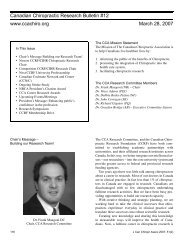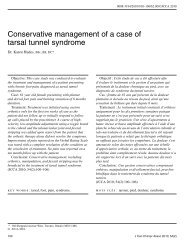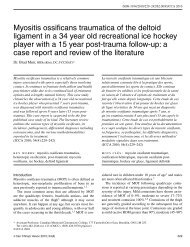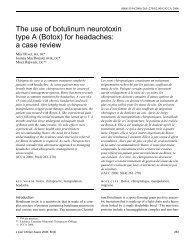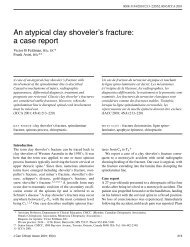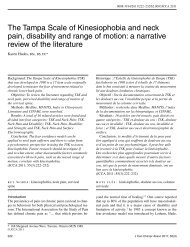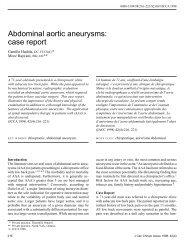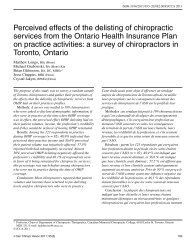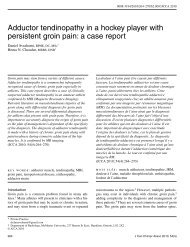Pronator quadratus – a forgotten muscle - Journal of the Canadian ...
Pronator quadratus – a forgotten muscle - Journal of the Canadian ...
Pronator quadratus – a forgotten muscle - Journal of the Canadian ...
Create successful ePaper yourself
Turn your PDF publications into a flip-book with our unique Google optimized e-Paper software.
0008-3194/2003/17<strong>–</strong>20/$2.00/©JCCA 2003RS Annis<strong>Pronator</strong> <strong>quadratus</strong> <strong>–</strong> a <strong>forgotten</strong> <strong>muscle</strong>:a case reportRobert S Annis, BSc, DC*The pronator <strong>quadratus</strong> (PQ) is a <strong>muscle</strong> that has beenvirtually <strong>forgotten</strong> since it was first documented fourcenturies ago. Little, if any, functional syndromes havebeen attributed to <strong>the</strong> PQ since that time nor have anythorough investigations been conducted with respect toit’s anatomy. In this case report, an instance <strong>of</strong> PQmy<strong>of</strong>ascial pain syndrome is described as well as <strong>the</strong>examination that lead to <strong>the</strong> diagnosis.(JCCA 2003; 47(1):17<strong>–</strong>20)KEY WORDS : pronator <strong>quadratus</strong>, compartment,syndrome, my<strong>of</strong>ascial pain.Le pronator <strong>quadratus</strong> (PQ) est un <strong>muscle</strong> qui a étéquasiment oublié depuis sa découverte il y a quatresiècles. Peu, voire aucun, syndrome fonctionnel n’aété attribué au PQ depuis cette époque et aucunerecherche n’a été menée sur son anatomie. Ce rapportde cas décrit l’occurrence du syndrome my<strong>of</strong>ascialdouloureux du PQ, ainsi que l’examen qui a conduit audiagnostic.(JACC 2003; 47(1):17<strong>–</strong>20)MOTS CLÉS : pronator <strong>quadratus</strong>, compartiment,syndrome, douleur my<strong>of</strong>asciale.IntroductionThe pronator <strong>quadratus</strong> (PQ) <strong>muscle</strong> has been described inanatomy texts for a few centuries, never<strong>the</strong>less, very littleinterest has been expressed in this <strong>muscle</strong> or it’s function.From an anatomical and functional perspective, this <strong>muscle</strong>has been relatively neglected. A recent article byStuart 1 has resurrected earlier studies <strong>of</strong> <strong>the</strong> anatomy <strong>of</strong>pronator <strong>quadratus</strong> indicating <strong>the</strong> dual-headed nature <strong>of</strong>this <strong>muscle</strong> (Figure 1). There was found to be a superficialhead (PQs) and a deep head (PQd). Apart from <strong>the</strong> twopapers sited by Stuart and his own investigation <strong>of</strong> PQ,<strong>the</strong>re is no mention <strong>of</strong> this <strong>muscle</strong>’s two headed anatomyin anatomical texts or literature. 1 From <strong>the</strong> investigations<strong>of</strong> Basmajian and DeLuca 2 using electromyographic examination<strong>of</strong> PQ, it has been shown that PQ is <strong>the</strong> primemover <strong>of</strong> forearm pronation in all positions <strong>of</strong> elbowflexion and extension.As mentioned above, <strong>the</strong>re is little literature on <strong>the</strong>anatomy and function <strong>of</strong> this <strong>muscle</strong> and even less on anypain syndromes related to <strong>the</strong> PQ. Only one case reportassociated with a separate PQ compartment syndromewas located in <strong>the</strong> literature. Summerfield et al. 3 relate acase <strong>of</strong> a worker sustaining an oblique distal radius fracturewith 15 degrees <strong>of</strong> volar angulation as well as multiplefractures <strong>of</strong> <strong>the</strong> metacarpals and phalanges. Uponexposure <strong>of</strong> <strong>the</strong> distal radius, <strong>the</strong> PQ was noted to be tenseand firm to palpation. With a compartment pressure <strong>of</strong>35<strong>–</strong>40 mmHg observed, using a Stryker manometer, afascial release was performed. In this particular instance,<strong>the</strong> authors feel that <strong>the</strong> PQ syndrome would not havebeen preoperatively diagnosed due to <strong>the</strong> underlying fractureand <strong>the</strong> associated pain.This is a case that <strong>the</strong> author has documented about aPQ my<strong>of</strong>ascial pain syndrome <strong>of</strong> insidious onset and alleviatedwith trigger point <strong>the</strong>rapy.* Research Associate, <strong>Canadian</strong> Memorial Chiropractic College, 1900 Bayview Avenue, Toronto, Ontario, Canada M4G 3E6. 416-482-2340.Request for reprints: Robert S Annis, 80 Normandy Court, Sudbury, Ontario P3A 2E8.© JCCA 2003.J Can Chiropr Assoc 2003; 47(1) 17
<strong>Pronator</strong> <strong>quadratus</strong>Type 1 <strong>–</strong> 20 specimensType 2 <strong>–</strong> 10 specimensType 3 <strong>–</strong> 9 specimens(Deep head covered by superficial)Type 4 <strong>–</strong> 1 specimenFigure 1Anatomical Variations <strong>of</strong> pronator <strong>quadratus</strong>* PQs <strong>–</strong> pronator <strong>quadratus</strong> superficial division: PQd <strong>–</strong> pronator <strong>quadratus</strong> deep division* Reprinted with permission <strong>of</strong> <strong>the</strong> WB Saunders Co., copyright; JHS Vol 21(6) 714<strong>–</strong>22 1996 (Figure 5)18 J Can Chiropr Assoc 2003; 47(1)
RS AnnisCase reportA 15-year-old right-handed healthy male student presentedto a multi disciplinary clinic for an assessment <strong>of</strong> apainful left wrist <strong>of</strong> sixteen months duration. The patientdescribed <strong>the</strong> pain as sharp during wrist movement anddull at o<strong>the</strong>r times and centred about <strong>the</strong> ulnar styloidprocess. There was radiation to approximately two-thirdsproximal to <strong>the</strong> wrist along <strong>the</strong> medial left forearm. Thepatient denied any initial trauma. The pain began mildlyand progressively worsened. All movements increased <strong>the</strong>pair as well as direct pressure on <strong>the</strong> area. Rest seemed togive some relief.Treatment had consisted <strong>of</strong> a wrist splint for one monthwith negative results. Physio<strong>the</strong>rapy in <strong>the</strong> form <strong>of</strong>stretches, ultrasound, ice, laser, T.E.N.S had been ongoing for <strong>the</strong> past eight months. This had not been helpful.Radiological examination as well as an arthrogram andMR imaging <strong>of</strong> <strong>the</strong> left wrist were negative.On examination, range <strong>of</strong> motion <strong>of</strong> <strong>the</strong> wrist wasnormal and painless except with ulnar deviation. Thisaction caused sharp pain in an area <strong>of</strong> about ten centimetresproximal to <strong>the</strong> wrist. Palpation along <strong>the</strong> length <strong>of</strong> <strong>the</strong>flexor carpi ulnaris tendon produced pain. Palpation <strong>of</strong> <strong>the</strong>pronator <strong>quadratus</strong> <strong>muscle</strong> with added digital pressurereproduced <strong>the</strong> patient’s symptoms with radiation along <strong>the</strong>ulna. The PQ exhibited hypertonia. Upper limb reflexeswere 2+, bilaterally. Finkelstein’s, Phalen’s, reverse Phalen’s,and carpal compression tests were negative. Dynamar (tm)grip strength was 36 right and 30 left. Resisted pronation <strong>of</strong><strong>the</strong> forearm in full flexion produced pain over <strong>the</strong> PQ withapproximately a grade IV strength index.A preliminary working diagnosis <strong>of</strong> PQ my<strong>of</strong>ascialpain syndrome was made.Consent from his legal guardian was obtained and <strong>the</strong>treatment plan was explained. Treatment consisted <strong>of</strong>my<strong>of</strong>ascial trigger point <strong>the</strong>rapy 4 (sustained digital pressureon an irritated trigger area) <strong>of</strong> <strong>the</strong> PQ <strong>muscle</strong> bellyand IFC (tetanizing/analgesic setting) for 15 minutes onthree separate visits for <strong>the</strong> first week. This procedure wasrepeated twice each week for <strong>the</strong> following two weeks and<strong>the</strong>n followed up at a two and a three-week interval. Thepatient was discharged asymptomatic after <strong>the</strong> last treatment(nine in total).DiscussionThis diagnosis was based on <strong>the</strong> work <strong>of</strong> Travell andSimons. 4 Although <strong>the</strong>y do not specifically identify <strong>the</strong> PQ<strong>muscle</strong> as having a my<strong>of</strong>ascial pain syndrome (MPS),based on <strong>the</strong>ir determination <strong>of</strong> o<strong>the</strong>r such syndromes, <strong>the</strong>characteristics <strong>of</strong> this particular presentation mimic o<strong>the</strong>rsthat <strong>the</strong>y have described (Table 1). Finding a site <strong>of</strong> localtenderness is essential for this diagnosis but is nonspecific.If a local twitch response and pain reproduction witha characteristic referral is found, <strong>the</strong>n this is specific anddiagnostic <strong>of</strong> a my<strong>of</strong>ascial trigger point. The more <strong>of</strong> <strong>the</strong>diagnostic criteria present (Table 1), <strong>the</strong> greater certaintyis <strong>the</strong> diagnosis. 4 Table 1Criteria for diagnosing active my<strong>of</strong>ascial TPs 4• history sudden onset during or shortly followingacute overload stress• gradual onset with chronic overload stress• specific characteristic pattern <strong>of</strong> pain referred frommy<strong>of</strong>ascial trigger points (TPs)• weakness and restriction in <strong>the</strong> stretch range <strong>of</strong>motion <strong>of</strong> <strong>the</strong> effected <strong>muscle</strong>• a taut, palpable band in <strong>the</strong> effected <strong>muscle</strong>• exquisite, local tenderness to digital pressure(<strong>the</strong> TP), in <strong>the</strong> band <strong>of</strong> taut <strong>muscle</strong> fibers• a local twitch response elicited through snappingpalpation or needing <strong>of</strong> <strong>the</strong> TP• reproduction <strong>of</strong> <strong>the</strong> patient’s complaint by pressureon, or needling <strong>of</strong> <strong>the</strong> TP• elimination <strong>of</strong> symptoms by <strong>the</strong>rapy directedspecifically to <strong>the</strong> effected <strong>muscle</strong>In this case, <strong>the</strong>re was a history <strong>of</strong> a gradual onset, a painreferral (not characteristic since none had previously beendescribed by Travell and Simons), weakness in <strong>the</strong> <strong>muscle</strong>,a taut palpable band in <strong>the</strong> affected <strong>muscle</strong>, <strong>the</strong> location<strong>of</strong> <strong>the</strong> trigger point and, reproduction <strong>of</strong> <strong>the</strong> patient’spain complaint by digital pressure on <strong>the</strong> trigger point.More importantly, <strong>the</strong> symptoms were eliminated by<strong>the</strong>rapy directed at <strong>the</strong> specific <strong>muscle</strong>.Without a specific classic model to compare to, thisdiagnosis was not apparent. Upper extremity compressionsyndromes such as anterior interosseous nerve (AIN) entrapmentsyndrome, carpal tunnel and pronator teres syndromemust be ruled out. These three will be brieflydiscussed to aid in <strong>the</strong> differential diagnosis.J Can Chiropr Assoc 2003; 47(1) 19
<strong>Pronator</strong> <strong>quadratus</strong>The pain <strong>of</strong> AIN may also occur spontaneously andcause an aching pain along <strong>the</strong> medial border <strong>of</strong> <strong>the</strong> forearmfrom <strong>the</strong> elbow and cross over to <strong>the</strong> anterior surface<strong>of</strong> <strong>the</strong> thumb. Paralysis usually follows shortly after <strong>the</strong>pain subsides. 5,6 In this case, <strong>the</strong> patient exhibited no signs<strong>of</strong> a nerve entrapment in <strong>the</strong> carpal tunnel (CTS). Therewas no indication <strong>of</strong> <strong>the</strong>nar <strong>muscle</strong> wasting, sensory loss<strong>of</strong> <strong>the</strong> lateral three digits and lateral part <strong>of</strong> <strong>the</strong> ring finger,and characteristic nocturnal awakening as seen in CTS. 7The clinical presentation <strong>of</strong> pronator teres syndrome has,as it’s most frequent symptom, an aching pain along <strong>the</strong>volar forearm, aggravated by repetitive use. The pronatorteres (PT) <strong>muscle</strong> may exhibit tenderness and have apositive Tinel’s sign over it. There may also be pares<strong>the</strong>siaalong <strong>the</strong> distribution <strong>of</strong> <strong>the</strong> median nerve when <strong>the</strong> forearmis pronated forcibly against resistance. 8The ulnar nerve may also be compressed at <strong>the</strong> elbow(cubital tunnel syndrome) and at <strong>the</strong> wrist (tunnel <strong>of</strong>Guyon). 9 The presenting complaint for cubital tunnel syndromeis medial forearm pain and pares<strong>the</strong>sia into <strong>the</strong> ringand little finger. This may be caused by a stretch on <strong>the</strong>nerve at <strong>the</strong> elbow or compression from <strong>the</strong> two heads <strong>of</strong><strong>the</strong> flexor carpi ulnaris or cubital tunnel osteophytes. Thesymptoms are produced by passive or resisted elbow flexionwith <strong>the</strong> elbow in a maximally flexed position. 9A complaint <strong>of</strong> numbness/tingling or pain in <strong>the</strong> fourthand fifth digits is <strong>the</strong> classic presentation <strong>of</strong> compression at<strong>the</strong> tunnel <strong>of</strong> Guyon. 9 Usually <strong>the</strong> ulnar nerve is compressedin <strong>the</strong> tunnel <strong>of</strong> Guyon. This compression may becaused by constant compression on handle bars (e.g., bicycles).Tests include Tinel’s at <strong>the</strong> tunnel or pressure at <strong>the</strong>pisiform hamate area. With Froment’s sign, weakness <strong>of</strong><strong>the</strong> adductor pollicis may be evident. Wartenberg’s sign(unable to fully adduct fingers) is positive.Compression pathologies <strong>of</strong> <strong>the</strong> radial nerve may occurat <strong>the</strong> radial tunnel (radial tunnel syndrome) or at <strong>the</strong>superficial branch <strong>of</strong> <strong>the</strong> radial nerve as it passes between<strong>the</strong> tendons <strong>of</strong> <strong>the</strong> extensor carpi radialis longus and <strong>the</strong>brachioradialis (Wartenberg’s syndrome).The presenting complaint with <strong>the</strong> radial tunnel syndromeis a dull aching pain over <strong>the</strong> lateral forearm. 9 Theradial nerve may be compressed at several locations, involving<strong>the</strong> radial head, medial edge <strong>of</strong> <strong>the</strong> extensor carpiradialis brevis, <strong>the</strong> arcade <strong>of</strong> Frohse (thickened edge <strong>of</strong> <strong>the</strong>superficial head <strong>of</strong> <strong>the</strong> supinator), and <strong>the</strong> two heads <strong>of</strong> <strong>the</strong>supinator <strong>muscle</strong>. There is tenderness distal to <strong>the</strong> lateralepicondyle.Wartenberg’s syndrome usually presents as a complaint<strong>of</strong> numbness or tingling over <strong>the</strong> dorsolateral aspect <strong>of</strong> <strong>the</strong>wrist and hand. 9 A positive Tinel’s sign is elicited at <strong>the</strong>dorsolateral wrist. Passive ulnar deviation and flexion <strong>of</strong><strong>the</strong> wrist may cause pain.ConclusionCareful questioning <strong>of</strong> <strong>the</strong> patient and consideration <strong>of</strong> <strong>the</strong>signs and presenting symptoms is necessary with patientspresenting with forearm and wrist pain. The ability to differentiatebetween <strong>the</strong> various compression syndromesand my<strong>of</strong>ascial TPs is critical if <strong>the</strong> correct treatment protocolis to be implemented expeditiously and effectively.As is evident in this case, not all conditions fall neatly intoa prescribed format. Practitioners must always be alert fornew causes <strong>of</strong> pain and for new ways to treat it.Although this may be a unique case presentation, it isworth investigating whe<strong>the</strong>r or not <strong>the</strong> PQ has an irritableTP in any wrist/forearm pain presentation. It may save aperson with this condition considerable aggravation.References1 Stuart PR. <strong>Pronator</strong> <strong>quadratus</strong> revisited. J Hand Surg [Br]1996 Dec; 21(6):714<strong>–</strong>722.2 Basmajian JV, Deluca CJ. Muscles alive: <strong>the</strong>ir functionsrevealed by electromyography, 5th edn. Baltimore,Williams and Wilkins, 1985.3 Summerfeild SL, Folberg CR, Weiss AP. Compartmentsyndrome <strong>of</strong> <strong>the</strong> pronator <strong>quadratus</strong>: a case report. J HandSurg [Am] 1997 Mar; 22(2):266<strong>–</strong>268.4 Travell JG, Simons DG. My<strong>of</strong>ascial pain and dysfunction:<strong>the</strong> trigger point manual. Baltimore, Williams and Wilkins,1984.5 Crawford JP, Noble WMJ. Anterior interosseous nerveparalysis: cubital tunnel (Kiloh-Nevin) syndrome.J Manipulative Physiol Ther 1988; 11(3):218<strong>–</strong>220.6 Spinner M. Injuries to <strong>the</strong> major branches <strong>of</strong> <strong>the</strong> peripheralnerves <strong>of</strong> <strong>the</strong> forearm. 2nd ed. Philadelphia, WB SaundersCo. 1978.7 Ross MA, Kimura J. AAEM case report No. 2: <strong>the</strong> carpaltunnel syndrome. Muscle and Nerve 1995; 18(6):567<strong>–</strong>573.8 Stewart JD. Focal peripheral neuropathies. New York,Elesevier, 1987.9 Sousa TA. Differential diagnosis for <strong>the</strong> chiropractor.Maryland Aspen Publishers Inc., chapter 9, 1998.20 J Can Chiropr Assoc 2003; 47(1)



